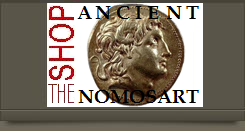
about ancient nomos
Ancient Nomos Art is a museum of galleries exhibiting ancient coins and ancient mint maps. The coin gallery displays the diverse art and history of hand-crafted ancient Greek, Roman, Byzantine, Persian and Medieval coinage. The ancient mints mapping gallery features Greek, Roman, Byzantine, Asia Minor and Medieval mint city regions and territories. Visitor's are welcome to explore, study and enjoy Ancient Nomos Art.

Baktrian Kingdom – 110 BC
King Philoxenos
From Ancient Galleries

Obverse: Diademed and draped bust of King Philoxenos Aniketos "The Invincible" facing right.
Reverse: Helmeted Philoxenos in military attire galloping on a rearing horse going charging right.
LEGEND SYMBOLS
Obv: Greek legend, BAΣIΛEΩΣ ANIKHTOY ΦΙΛOΞENOY, “Of the Invincible King Philoxenos” translation. Diademed and draped bust of King Philoxenos facing right. Rev: Kharosthi legend,![]() , as ‘Maharajasa Apadihatasa Philasinasa’ “Undefeatable King Philoxenos” translation. Helmeted King Philoxenos galloping on a rearing horse going right, dressed in military attire; monograms
, as ‘Maharajasa Apadihatasa Philasinasa’ “Undefeatable King Philoxenos” translation. Helmeted King Philoxenos galloping on a rearing horse going right, dressed in military attire; monograms ![]() and
and ![]() in fields below horse.
in fields below horse.
Most of the Baktrian Kingdom and the individual kings and rulers are known to historians by way of the Indo-Greek coinage record and subsequent research by Numismatists and Scholars. The Baktrian King Philoxenos Aniketos, known as “The Invincible” by his reverse legend inscriptions, are extremely rare. The exceptional silver tetradrachm above was issued on the ancient Indian weight standard (a reduced Greek Attic standard) with bilingual Greek and Kharosthi script legends. His coinage finds have been discovered primarily in the Baktria region of Punjab, Paropamisade and Gandhara (modern day Afghanistan), where Philoxenos’ reign seems to have been located. Philoxenus seems to have been quite an important king who might briefly have ruled most of the Indo-Greek territory. Historians have not yet connected Philoxenus with any dynasty, but he could have been the father of the princess Kalliope, who was married to the king Hermaeus. Philoxenus struck several series of bilingual Indian silver coins, with a reverse of a mounted king, a type previously used as obverse by Antimachus II sixty years earlier and as reverse on rare types of Nicias. Whether the equestrian was a dynastic emblem or a portrait of the king as a cavalryman is unclear. Several Saka kings used similar equestrians on their coinage. His drachms were unusual since they were all square shaped a feature that was rare among Indo-Greeks but standard for Sakas and this indicates that Philoxenus had connections with earlier Indus nomads that had previously conquered Baktria. The extreme scarcity of his coinage indicates his reign must have been very brief. Bopearachchi dates his reign to circa 100-95 BC, whereas O.D. Hoover in his Handbook of Coins of Baktria, volume 12, dates it somewhat earlier to, circa 125-110 BC.
DOCUMENTATION
Value: Bilingual Tetradrachm. Metal: AR Silver. Weight: 9.38 grams. Mint: Baktria. Date: 125-110 BC.
Attribution: Bopearachchi, Monnaies Gréco-Bactriennes et Indo-Grecques, 3H; Bopearachchi & Rahman, Pre-Kushana Coins in Pakistan; SNG American Numismatic Society Collection, 1164-7.
Legend, Documentation and Attribution
